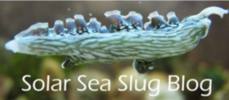

Ten Interesting Factoids About Solar Slugs
Not surprisingly, many of the comments that have been posted by others on the blog are spam, and many of these are helpful people with names like “Central Air Conditioning,” and offer assistance in increasing traffic on the site.
To be honest, although I would like for the site to be useful to all of the denizens of the InterWeb, the site is mainly a way for me to keep track of my progress, along with helping me organize the links and literature comprising the world of slugs. So, I am not particularly interested in increasing traffic for the time being.
Nonetheless, maybe it’s time to generate a little click bait. While not to the high standards of “10 things Kim Kardashian will eat today” or “11 things your dog hates,” there are plenty of catchy lists to be made with all the fascinating information from the world of sacoglossan biology.
Here are ten things you should know about Elysia, in no particular order.
1. They suck sap. Like other sacoglossans, they pierce the cell walls of their food plants with rasping mouthparts, the radulla, and suck out the contents.
2. Larvae are lecithotrophic, meaning they live off of stored yolk while they are in the brief free swimming, or veliger, stage. This means that they do not have to find food during this period.
3. Larvae metamorphose rapidly. With some exceptions, the veliger stage lasts only a few days, and the juvenile slugs settle onto their food plants and begin their benthic (bottom dwelling) lives.
4. They like to float randomly. Although this may not apply to all species, captive E. clarki and E. crispata like to release their hold on the substrate from time to time. They often skim the surface layer, and also float around in the water column. This may not be a natural behavior, but I have observed wild E. crispata “going for a float” when launched by the current generated by a passing fish. Whether this behavior aids dispersal or is simply a byproduct of being the same density as seawater is unclear.
5. They are hermaphrodites. Adult Elysia produce both eggs and sperm at the same time. They cannot fertilize themselves, but can mate with anyone of the same species that they encounter. Was it Woody Allen who said it doubles your chance of finding a date on Saturday night?
6. They steal chloroplasts. When they suck the sap from their food plants, the chloroplasts (photosynthetic subcellular structures) are taken and moved to digestive diverticula, which are special outpouchings of the digestive system. The chloroplasts can be maintained for many months, and produce measurable amounts of energy for the slugs. Contrary to earlier reports, however, photosynthesis by these stolen chloroplasts (“kleptoplasts”) is not enough to stave off starvation.
7. Several Elysia species are being studied as sources of potential therapeutics. As can be found in the Natural Products page, the slugs contain chemicals derived from their food plants that may be useful in treatment of cancer and other disorders.
8. Elysia species often eat a variety of food plants. Many slugs, such as nudibranchs, are highly specialized to feed on a single kind of animal or plant. Although this may be the case for some species of Elysia, many will accept multiple plant species. Further, there have been reports that juveniles prefer different plants from adults.
9. They have adapted to many climates and conditions. For example, on the east coast of North America, Elysia species range from Nova Scotia to the Caribbean. As an example of the range of ecological adaptations, Elysia crispata is commonly found on corals reefs, while E. catulus is restricted to seagrass beds.
10. Elysia do not have gills. The large surface area generated by their parapodia allows them to perform gas exchange through their skin, obviating the need for gills. They are frequently, and erroneously referred to as nudibranchs because of their superficial similarity to this group, but nudibranchs have prominent gills, as illustrated by the fact that their name means “naked gills.”
Really interesting!
I don’t know why I find this so fascinating, but inexplicably I do.
Inexplicable? These are facts about solar slugs for crying out loud. What could be more fascinating?